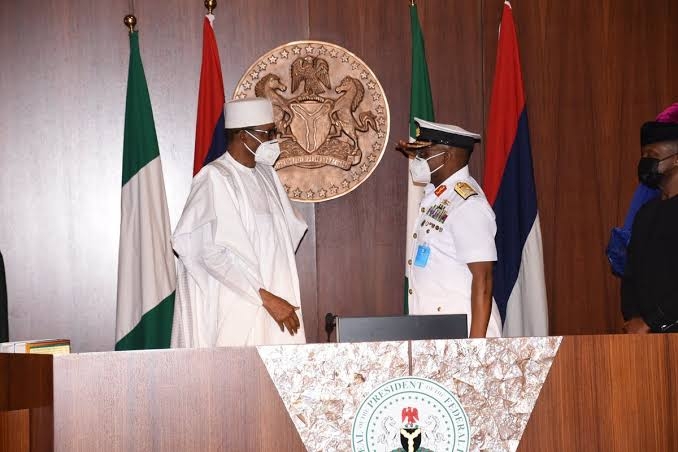To keep the nation’s waters safe from all types of maritime threats, the Nigerian Navy (NN) has conceptualized a multi-layered Total Spectrum Maritime Strategy (TSMS).
The multi-layered Total Spectrum Maritime Strategy (TSMS) covers measures that include the defense of Nigeria’s territorial integrity, prevention of illegal activities in the nation’s EEZ, enforcement of maritime regulations, and safety of lives at sea, and prevention of illegal activities in the nation’s backwaters.
The strategy emphasis effective maritime surveillance, response capabilities, and enforcement of the nation’s maritime laws.
This strategy was disclosed by the Chief of Naval Staff Vice Admiral AZ Gambo during the graduation ceremony of the fifth iteration of the naval warfare course on 5 August.

“To achieve her Mission objectives, the NN has over the past 5 years made concerted efforts to implement the Strategic Plan along identified lines; fleet renewal, infrastructure, and logistics as well as HRM and capacity building.”
The Nigerian Navy strategic goal in the short, medium, and long term was presented in 2009, and its requirement is outlined thus;
In the short-term two light frigates, two 85 meter OPVs, six 17 meter Manta Class IPCs, two 38 meter FPBs, six Shaldag MK 11 patrol crafts two combat Augusta A138 helicopters, one Landing Platform Dock, and two Logistics Ships.
While the medium-term spanning two-five years would require ten OPVs, 20 helicopters, one hydrographic ship, two training ships, two logistics ships, and two mine countermeasure vessels (MCMVs).
In the long term spanning between five to ten years, the Nigerian Navy will require three Conventional Submarines, two corvettes, two LPDs, 20 long-range maritime patrol helicopters, two training ships, and two MCMVs.
Accordingly, the NN prioritized her activities, projects, budgets, and plans in line with these pillars: fleet renewal, logistics, and infrastructure, operational capacity building.
Vice Admiral AZ Gambo explains that with the ongoing fleet expansion, the Nigerian Navy earlier this year received two patrol vessels from Damen and is acquiring two more offshore patrol vessels, unmanned aerial vehicles, as well as fast patrol craft from China.
The NN has acquired offshore patrol vessels, fast attack craft, and more than 300 inshore patrol crafts.
Within the short-to-medium term include 100m Landing Ship Tank from DAMEN Shipyard-Netherlands, 45m Fast Patrol Craft from Poly Technology Incorporated-China while the contract for 35m Hydrographic Survey Ship has been signed with OCEA Shipbuilding.

The NN is also in the process of procuring UAVs to enhance our response capability.
In the area of local shipbuilding, the construction of SDB III as well as water and fuel barges and houseboats are progressing steadily.
The fleet renewal has paid off, with increased Nigerian Navy footprints across the maritime domain leading to the arrest of hundreds of suspected criminals for various maritime offenses in the last five years.
For instance, from Jan to 26 May 2021, there were only 8 pirate attacks in the Gulf of Guinea, while only 5 were within Nigeria waters. And most of these attacks in Nigerian waters were aborted arising from the prompt response of the NN ships on patrol through a robust MDA infrastructure.
Despite these significant gains, Vice Admiral Z Gambo noted that the NN still have a shortfall of about 8 Offshore Patrol Vessels (OPVs) and about 69 Fast Attack Craft.
Also, NNS CALABAR, one of NN’s new OCEA patrol boats sank along Badagry Creek in March 2019 while 5 other patrol vessels sank between April 2018 and Jan 2020 around the Escravos channel, due to a collision with submerged wrecks.
These adequacies have adversely affected the NN capacity to effectively secure the nation’s maritime environment thus, making sustained fleet recapitalization effort a top priority in the NN.





 العربية
العربية 简体中文
简体中文 繁體中文
繁體中文 Nederlands
Nederlands Français
Français Deutsch
Deutsch עִבְרִית
עִבְרִית Italiano
Italiano 日本語
日本語 한국어
한국어 فارسی
فارسی Português
Português Русский
Русский Español
Español Türkçe
Türkçe Українська
Українська